 Facebook
Facebook
 X
X
 Instagram
Instagram
 TikTok
TikTok
 Youtube
Youtube
Graffiti is nothing new along transit routes. The local trolley's general manager was quoted in 1987 saying graffiti clean-up was a high priority. "When graffiti is noticed, it is our policy to remove it immediately."
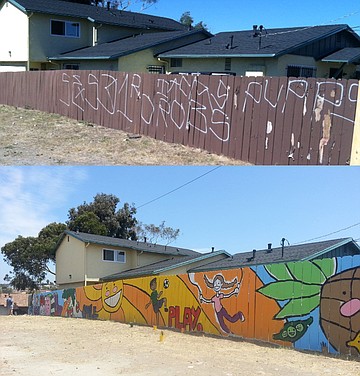
But the problem persists. According to a June report grand jury members found as they traveled the county via trolley, coaster, and bus that "graffiti was clearly evident in and around all areas of mass transit."
The trolley's clean-up policy is in place with Metropolitan Transit System or MTS (bus, trolley) and North County Transit District or NCTD (Coaster, Sprinter) who do daily inspections with 24-hour turnaround on graffiti cleanup within their domain.
When reporting graffiti to different agencies (online, hotlines, smartphone aps) grand jury members found it mostly difficult.
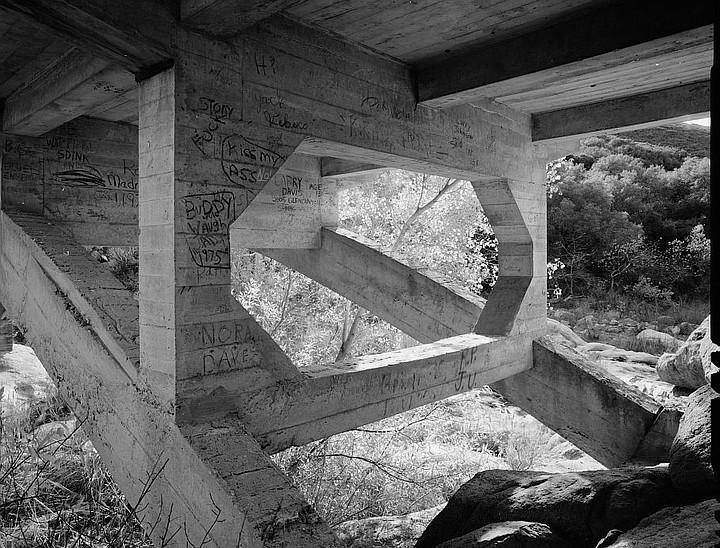
Searching for "report graffiti" on both the MTS and NCTD websites wasn't fruitful. Not until finding "customer feedback" links was I on the right track, but even then "graffiti reporting" wasn't called out.
The county's website easily yielded graffiti reporting instructions.
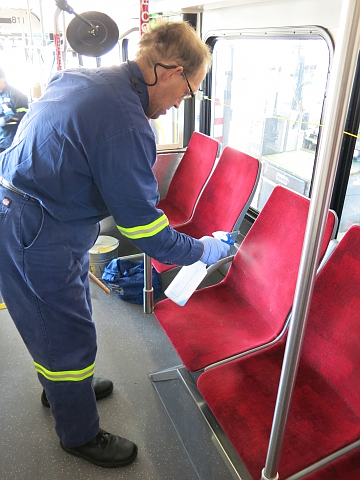
Members said bus and trolley signage didn't clearly define "how and where to report graffiti." Representatives from MTS and NCTD said this signage is in every car. The confusion could be that signs may not specifically mention graffiti, as all incidents are reported through the same portals.
The grand jury's key recommendation was to centralize graffiti reporting countywide. A similar suggestion was made in a 2014 county audit on graffiti control. That report also pointed to budgets that kept going down ($1,487,086 in FY2008 to $795,654 in FY2013).
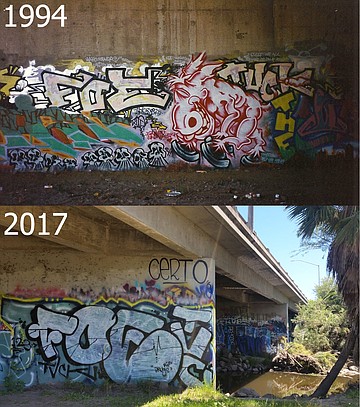
In 2015, Mayor Kevin Faulconer centralized city of San Diego efforts by implementing one hotline to report public and private property graffiti. Faulconer then stepped it up again with the unveiling of the Get it Done app in 2016.
The grand jury gave major kudos to Faulcolner's Get it Done app saying it could be the basis for a centralized system countywide.
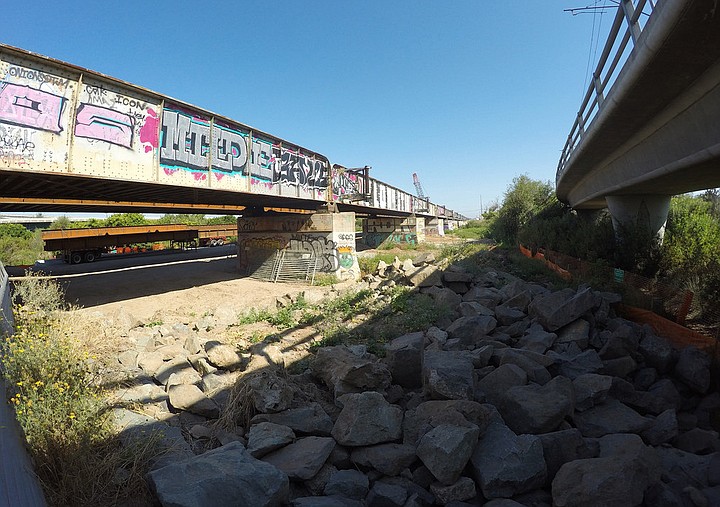
Laurie Saint said it works. "I've reported graffiti dozens of times [online] and it gets cleaned up or painted over in about a week."
The city had 13,274 graffiti complaints in 2017 and more than 1600 in January 2018.
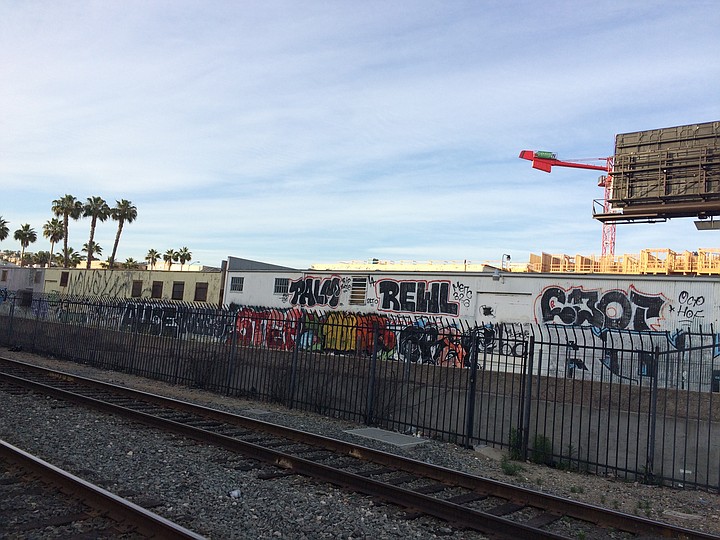
One centralized system that MTS, the county, the police department and other cities use is Graffiti Tracker, a database used to keep track of incidents by taggers. According to Officer Joshua Hodge, the San Diego Police Department has been using it since 2007.
"Many more taggers get caught now with the use of graffiti tracker. The tracker links the cases by comparing the monikers tagged. We can submit a case based upon tracker information and identification of the suspect."
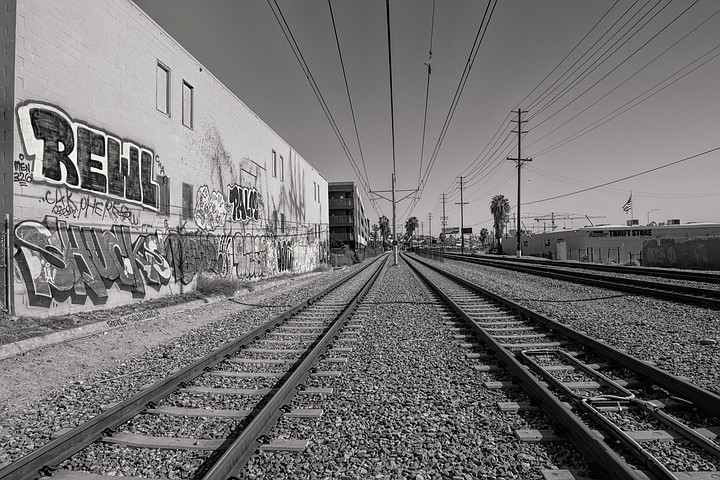
"To date the tagger with the most tags over the last year goes by 'FOE TVC.' Over the last year, this tagger has been documented with 106 tags by graffiti tracker for a total restitution of $11,705.04. The person is not in custody at this time."
I found several images online of tagging by "FOE TVC" between 1994 and 2017.
Graffiti Tracker has caught other prolific taggers including Bladimir Lopez of Vista who was arrested for 300 incidents in 2014. The cost to clean up Lopez's graffiti was $89,500.
Rob Schupp with MTS said a lot of the graffiti seen when riding the trolley is "adjacent to our tracks," on property not owned by MTS. Schupp, who rides the Coaster to work, says there is considerable graffiti off MTS property between Old Town and downtown San Diego.
Schupp said they still use ARC, a unique partnership that began in 2005 that hires those with disabilities to keep their fleet clean.
The annual budget of $1 million for the trolley to address vandalism doesn't separate out graffiti or taggers from people throwing rocks and smashing skateboards through windows. "Broken windows are a huge issue in trolleys. Etching of windows is another frequent problem.”
Both Schupp and Sean Loofbourrow, chief of safety and security of NCTD, said both MTS and NCTD regularly communicate with other agencies and municipalities about vandalism outside of their domains.
Loofbourrow said NCTD has a maintenance team that maintains 60 miles of rail up to the Orange County line. "If they see [vandalism], a work order is made right there or they remedy it on the spot." Loofbourrow confirmed that vandalized windows are also an issue with NCTD.
"The artists, as they like to refer to themselves, that's how they gain popularity. It's a constant battle that you have to deal with on a daily basis. We want them to know if they spray paint something on our property, we will erase it right away."
Loofbourrow said it's a matter of making people feeling safe.
Surveys conducted in the 1990s found perception was that tagging was gang-related. This perception still holds true for many today. One person that used to run a graffiti abatement program said tagging is often a call for violence against other gangs.
Loofbourrow said the majority of graffiti isn't reported by complaints. So far in 2018, there have only been 29 reports. Sixty percent were located along the railroad right-of-way and forty percent in transit centers. Oceanside had the most reports (11), but the numbers are skewed because eight were reported by the same individual. It was a case of NCTD having to clean up the same site repeatedly. "It's a constant drumbeat you have to deal with. You can't just fix it and walk away."
Jessica Gonzales from Sandag said they don't handle graffiti complaints directly but instead promote the use of a county page that flows into Graffiti Tracker.
Stances on graffiti run the gamut. Some find it interesting and post photographs on social media of what they find around San Diego. Some separate out tagging as vandalism and graffiti as art, while others say tagging should be honored having been around since ancient times. Where everyone seems to be on the same page is when it comes to not wanting illegal graffiti or tagging in their own neighborhoods.
In 2008, the city council went all in on zero tolerance on graffiti by amending the municipal code to charge vandals under state law and to restrict access to graffiti supplies in stores.
Ground zero methods to deter graffiti include hanging artificial ivy on a graffiti covered wall (Amtrak used this locally) and painting murals.
Brise Birdsong designs murals in San Diego to prevent tagging in heavily vandalized neighborhoods. One mural she helped design on Naranja & Euclid with local kids in 2013 has been tagged "but not to the degree as it was previously."
Even street art in historically designated areas like Chicano Park can fall victim to tagging, though it might be more so if not for the murals.
Birdsong said in her experience when the community takes part in their neighborhood's beautification, vandalism decreases.
The lure in doing graffiti for some local "crews" (as they call themselves) is the dream of "rocking legal walls." It's hard to ignore graffiti artists like Oscar-nominated Banksy whose illegal graffiti has sold at auction for hundreds of thousands to more than a million dollars. Graffiti is used in mainstream advertising and even local transit has wrapped cars with "blight branding" graffiti.
Some argue that art needs to be more accessible where people are instead of being locked up in museums or galleries. This is the inspiration behind Wonderspaces, a pop-up art show open though August at the B Street Pier that includes a collective of artists including "illegal art."
I struck out with a graffiti artist interview, but found a 2016 video interview of a local graffiti artist. "Spictro" has been doing graffiti for about 15 years and has a penchant for graffiti on trains and world travel. He was interviewed in a black ski mask.
Spictro commented on how nice it is to see some of the older taggers making a comeback. When asked about his favorite medium, he replied, "I pretty much fuck with everything."
His favorite places to do graffiti are Barcelona, Florence, Hawaii, Portland, Santa Cruz, and Santa Barbara.
His advice for aspiring artists is to be "dedicated to the craft," "pay their dues," and to "fucking respect the scene. Follow the rules. Don't tag on the outside of yards, don't go over shit you didn't [graffiti]."
At the end of the interview, Spictro gave a shout out to graffiti artists he respects including "Eyesore."
The county board of supervisors, NCTD, and MTS have until September 4 to respond to the grand jury report.

Graffiti is nothing new along transit routes. The local trolley's general manager was quoted in 1987 saying graffiti clean-up was a high priority. "When graffiti is noticed, it is our policy to remove it immediately."

But the problem persists. According to a June report grand jury members found as they traveled the county via trolley, coaster, and bus that "graffiti was clearly evident in and around all areas of mass transit."
The trolley's clean-up policy is in place with Metropolitan Transit System or MTS (bus, trolley) and North County Transit District or NCTD (Coaster, Sprinter) who do daily inspections with 24-hour turnaround on graffiti cleanup within their domain.
When reporting graffiti to different agencies (online, hotlines, smartphone aps) grand jury members found it mostly difficult.

Searching for "report graffiti" on both the MTS and NCTD websites wasn't fruitful. Not until finding "customer feedback" links was I on the right track, but even then "graffiti reporting" wasn't called out.
The county's website easily yielded graffiti reporting instructions.

Members said bus and trolley signage didn't clearly define "how and where to report graffiti." Representatives from MTS and NCTD said this signage is in every car. The confusion could be that signs may not specifically mention graffiti, as all incidents are reported through the same portals.
The grand jury's key recommendation was to centralize graffiti reporting countywide. A similar suggestion was made in a 2014 county audit on graffiti control. That report also pointed to budgets that kept going down ($1,487,086 in FY2008 to $795,654 in FY2013).

In 2015, Mayor Kevin Faulconer centralized city of San Diego efforts by implementing one hotline to report public and private property graffiti. Faulconer then stepped it up again with the unveiling of the Get it Done app in 2016.
The grand jury gave major kudos to Faulcolner's Get it Done app saying it could be the basis for a centralized system countywide.

Laurie Saint said it works. "I've reported graffiti dozens of times [online] and it gets cleaned up or painted over in about a week."
The city had 13,274 graffiti complaints in 2017 and more than 1600 in January 2018.

One centralized system that MTS, the county, the police department and other cities use is Graffiti Tracker, a database used to keep track of incidents by taggers. According to Officer Joshua Hodge, the San Diego Police Department has been using it since 2007.
"Many more taggers get caught now with the use of graffiti tracker. The tracker links the cases by comparing the monikers tagged. We can submit a case based upon tracker information and identification of the suspect."

"To date the tagger with the most tags over the last year goes by 'FOE TVC.' Over the last year, this tagger has been documented with 106 tags by graffiti tracker for a total restitution of $11,705.04. The person is not in custody at this time."
I found several images online of tagging by "FOE TVC" between 1994 and 2017.
Graffiti Tracker has caught other prolific taggers including Bladimir Lopez of Vista who was arrested for 300 incidents in 2014. The cost to clean up Lopez's graffiti was $89,500.
Rob Schupp with MTS said a lot of the graffiti seen when riding the trolley is "adjacent to our tracks," on property not owned by MTS. Schupp, who rides the Coaster to work, says there is considerable graffiti off MTS property between Old Town and downtown San Diego.
Schupp said they still use ARC, a unique partnership that began in 2005 that hires those with disabilities to keep their fleet clean.
The annual budget of $1 million for the trolley to address vandalism doesn't separate out graffiti or taggers from people throwing rocks and smashing skateboards through windows. "Broken windows are a huge issue in trolleys. Etching of windows is another frequent problem.”
Both Schupp and Sean Loofbourrow, chief of safety and security of NCTD, said both MTS and NCTD regularly communicate with other agencies and municipalities about vandalism outside of their domains.
Loofbourrow said NCTD has a maintenance team that maintains 60 miles of rail up to the Orange County line. "If they see [vandalism], a work order is made right there or they remedy it on the spot." Loofbourrow confirmed that vandalized windows are also an issue with NCTD.
"The artists, as they like to refer to themselves, that's how they gain popularity. It's a constant battle that you have to deal with on a daily basis. We want them to know if they spray paint something on our property, we will erase it right away."
Loofbourrow said it's a matter of making people feeling safe.
Surveys conducted in the 1990s found perception was that tagging was gang-related. This perception still holds true for many today. One person that used to run a graffiti abatement program said tagging is often a call for violence against other gangs.
Loofbourrow said the majority of graffiti isn't reported by complaints. So far in 2018, there have only been 29 reports. Sixty percent were located along the railroad right-of-way and forty percent in transit centers. Oceanside had the most reports (11), but the numbers are skewed because eight were reported by the same individual. It was a case of NCTD having to clean up the same site repeatedly. "It's a constant drumbeat you have to deal with. You can't just fix it and walk away."
Jessica Gonzales from Sandag said they don't handle graffiti complaints directly but instead promote the use of a county page that flows into Graffiti Tracker.
Stances on graffiti run the gamut. Some find it interesting and post photographs on social media of what they find around San Diego. Some separate out tagging as vandalism and graffiti as art, while others say tagging should be honored having been around since ancient times. Where everyone seems to be on the same page is when it comes to not wanting illegal graffiti or tagging in their own neighborhoods.
In 2008, the city council went all in on zero tolerance on graffiti by amending the municipal code to charge vandals under state law and to restrict access to graffiti supplies in stores.
Ground zero methods to deter graffiti include hanging artificial ivy on a graffiti covered wall (Amtrak used this locally) and painting murals.
Brise Birdsong designs murals in San Diego to prevent tagging in heavily vandalized neighborhoods. One mural she helped design on Naranja & Euclid with local kids in 2013 has been tagged "but not to the degree as it was previously."
Even street art in historically designated areas like Chicano Park can fall victim to tagging, though it might be more so if not for the murals.
Birdsong said in her experience when the community takes part in their neighborhood's beautification, vandalism decreases.
The lure in doing graffiti for some local "crews" (as they call themselves) is the dream of "rocking legal walls." It's hard to ignore graffiti artists like Oscar-nominated Banksy whose illegal graffiti has sold at auction for hundreds of thousands to more than a million dollars. Graffiti is used in mainstream advertising and even local transit has wrapped cars with "blight branding" graffiti.
Some argue that art needs to be more accessible where people are instead of being locked up in museums or galleries. This is the inspiration behind Wonderspaces, a pop-up art show open though August at the B Street Pier that includes a collective of artists including "illegal art."
I struck out with a graffiti artist interview, but found a 2016 video interview of a local graffiti artist. "Spictro" has been doing graffiti for about 15 years and has a penchant for graffiti on trains and world travel. He was interviewed in a black ski mask.
Spictro commented on how nice it is to see some of the older taggers making a comeback. When asked about his favorite medium, he replied, "I pretty much fuck with everything."
His favorite places to do graffiti are Barcelona, Florence, Hawaii, Portland, Santa Cruz, and Santa Barbara.
His advice for aspiring artists is to be "dedicated to the craft," "pay their dues," and to "fucking respect the scene. Follow the rules. Don't tag on the outside of yards, don't go over shit you didn't [graffiti]."
At the end of the interview, Spictro gave a shout out to graffiti artists he respects including "Eyesore."
The county board of supervisors, NCTD, and MTS have until September 4 to respond to the grand jury report.
Comments